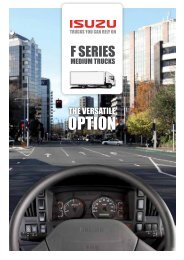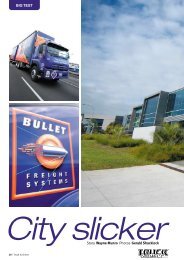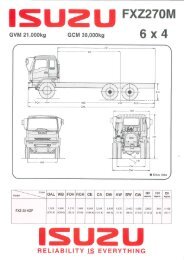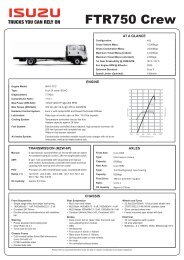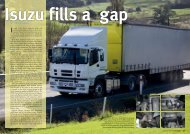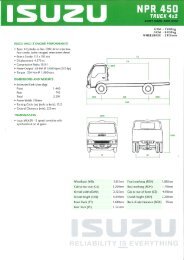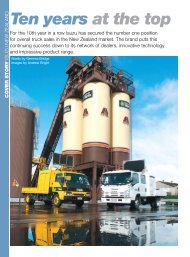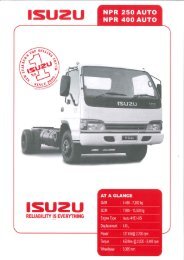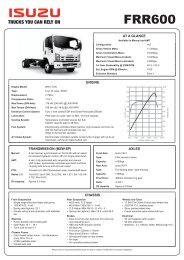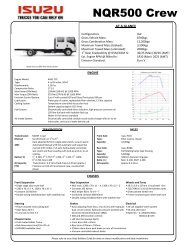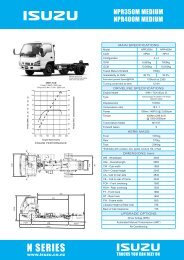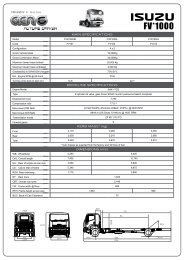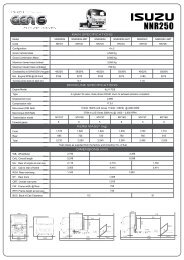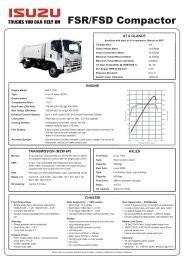Burning need for - Isuzu
Burning need for - Isuzu
Burning need for - Isuzu
Create successful ePaper yourself
Turn your PDF publications into a flip-book with our unique Google optimized e-Paper software.
<strong>Burning</strong> <strong>need</strong> <strong>for</strong><br />
<strong>Isuzu</strong><br />
B y J o h n M u r p h y<br />
When rural fire authorities choose a new fire truck, it is an even more important<br />
buying decision than usual – literally, a matter of life and death.<br />
The Te Uri farming community in the<br />
Tararuas is, according to locals, famous<br />
<strong>for</strong> its wind. It is isolated, too, being<br />
35 kilometres from the east coast and a<br />
similar distance from Dannevirke. When fires<br />
destroyed a home and a substantial area of<br />
bush in 1997, on both occasions it took fire<br />
trucks about an hour to reach the blaze via<br />
narrow, steep country roads. Local farmers<br />
Noel and Lola Percy counted the cost and<br />
decided Te Uri <strong>need</strong>ed a local volunteer Rural<br />
Fire Force.<br />
The region mostly depends on sheep and<br />
beef farms, but <strong>for</strong>estry is playing a bigger role,<br />
28 NZ Trucking October 2010
with more blocks<br />
being planted. The<br />
area’s location on the east of the ranges means it<br />
becomes dry over summer, so one of its primary<br />
incomes is particularly vulnerable to fire.<br />
Ian Millman, manager national resources<br />
and development with the National Rural Fire<br />
Authority (NRFA), says many isolated communities<br />
like Te Uri recognise the fire danger<br />
and ask <strong>for</strong> help in procuring a suitable vehicle.<br />
Where they can, the NRFA works with the<br />
district council to link up the volunteers with a<br />
retired fire truck and provide training to national<br />
standards, hopefully enabling the community<br />
to deal with the emergency and keep it under<br />
control until rein<strong>for</strong>cements arrive.<br />
Noel, Lola, the community and the Tararua<br />
District Council developed their fire <strong>for</strong>ce and<br />
received an ex-Fire Service 1975 Dodge V8,<br />
petrol-powered truck. Noel kept the Dodge in<br />
a shed at his place, and the community raised<br />
funds to build a new shed beside the hall and<br />
add to the fire fighting gear – proof that they<br />
were serious about providing a decent emergency<br />
service.<br />
Recently Te Uri became one of the lucky<br />
stations to receive one of the latest batch of<br />
five <strong>Isuzu</strong>s, the first with bodies built in New<br />
Zealand. “It has really changed our image,” Lola<br />
says.<br />
Te Uri didn’t get the new truck <strong>for</strong> nothing;<br />
the NRFA came up with two-thirds and the<br />
Tararua District Council with the other third <strong>for</strong><br />
the basic truck, with the local community footing<br />
the rest of the bill <strong>for</strong> equipment. Fund raising<br />
is an important part of the volunteers’ role.<br />
For six years, Ian has been allocating <strong>Isuzu</strong> 4x4<br />
seven-tonners as rural fire trucks and now has 45<br />
of them around the country. He says it was quite<br />
a change in mindset to go to the smaller 4x4s<br />
after traditionally using larger trucks with 13 or<br />
14 tonne GVMs.<br />
Most of the volunteers manning the trucks are<br />
farmers. When surveyed, they said they wanted a<br />
fire fighting vehicle that would drive like a fourwheel-drive<br />
ute and get to the same places. The<br />
older designs were really a hang-over from the<br />
days of the Forest Service when it was necessary<br />
to carry a large amount of water, and the roads<br />
were generally good and designed <strong>for</strong> trucks.<br />
Roads in the farming communities are often<br />
steep, narrow and winding. Access to farm buildings<br />
and houses are often through narrow gateways<br />
with overhanging trees. The trucks carry<br />
1800 litres but, as water can usually be found<br />
nearby, they don’t <strong>need</strong> to carry large volumes.<br />
When Ian drew up the specification list, the<br />
<strong>Isuzu</strong> NPS300 was the only model that really<br />
made the grade, largely because the strong little<br />
The omnipresent fireman’s<br />
axe is always within easy<br />
reach.<br />
The tyres are a<br />
compromise, providing<br />
reasonable on and off-road<br />
per<strong>for</strong>mance.<br />
Dash layout is clean and<br />
practical.<br />
An additional guard<br />
protects the lower radiator<br />
and other vulnerable parts.<br />
Couplings and valves<br />
abound on the small but<br />
important truck.<br />
October 2010 NZ Trucking 29
Japanese had a seven-tonne GVM, while the<br />
competition mostly had a six-tonne rating. The<br />
design weight came to about 6.3 tonnes with<br />
three people and equipment on board, so a sixtonner<br />
was out of the picture. Last year <strong>Isuzu</strong><br />
dropped the model’s rating to 6.5 tonnes, so the<br />
new units are sitting close to maximum GVM.<br />
Ian says they have to be careful not to overload<br />
the front axle. Every locker and tray on the unit<br />
has a maximum weight clearly indicated on the<br />
opening.<br />
When searching <strong>for</strong> the ideal truck, Ian visited<br />
Australia and was happy to find that his counterparts<br />
in Queensland were using the same<br />
<strong>Isuzu</strong> units and adding about 30 every year. He<br />
brought three of them to New Zealand and,<br />
<strong>Isuzu</strong>’s five-speed<br />
transmission with high<br />
and low ranges is ideal<br />
<strong>for</strong> the National Rural Fire<br />
Authority.<br />
Good map pocket storage<br />
is available above the<br />
windscreen.<br />
An adjustable map reading<br />
light is an essential<br />
addition to the <strong>Isuzu</strong>.<br />
30 NZ Trucking October 2010
after a few changes to the pumping system, they<br />
went on duty.<br />
With a width of only two metres, the truck<br />
can easily fit through tight gateways and negotiate<br />
narrow winding roads and farm tracks com<strong>for</strong>tably.<br />
Naturally enough there were some grumbles,<br />
you’re never going to satisfy everyone, especially<br />
such a wide group of volunteers. Things like<br />
a single cab and not being allowed to tow a<br />
trailer with extra hoses and equipment upset a<br />
few, but Ian was adamant that the truck would<br />
be to a national standard so that any volunteer<br />
could leap in a truck and be instantly familiar<br />
with it. The fire trucks are designed to be<br />
operated by two or, ideally, three volunteers, so<br />
the extra space of a double cab was of limited<br />
value and would reduce the water capacity by<br />
half. Volunteers arriving later usually follow in<br />
another vehicle.<br />
The fire trucks <strong>need</strong> a reasonable power to<br />
weight ratio; again, some of the competition<br />
did not come up to the 22hp per tonne criteria<br />
specified. Ian says the <strong>Isuzu</strong> engine’s per<strong>for</strong>mance<br />
is fantastic. A disadvantage of the older, secondhand<br />
units is their lack of acceleration, and<br />
the authority found drivers tried to overcome<br />
the issue by going into corners too fast, rather<br />
than lose speed. Since the <strong>Isuzu</strong> has the grunt to<br />
get back up to speed quickly, they are happy to<br />
slow down to enter the corner at a safe speed.<br />
Likewise, it per<strong>for</strong>ms well on hills and they don’t<br />
Noel Percy (left) and<br />
David Livingstone hold the<br />
trophy that Te Uri has won<br />
by beating the other three<br />
Tararua Rural Fire Authority<br />
teams in competitions <strong>for</strong><br />
the last two years.<br />
October 2010 NZ Trucking 31
The <strong>Isuzu</strong> excels on narrow<br />
farm tracks.<br />
A bull-bar is a handy<br />
addition, along with ferry<br />
tie-downs that double as<br />
towing eyes.<br />
have to suffer the embarrassment of being overtaken<br />
on their way to an emergency. The drivers<br />
are not allowed to exceed the speed limit, even<br />
though they are all trained and certified to drive<br />
an emergency vehicle.<br />
Ian admits to a Henry Ford mentality that<br />
likes to keep things simple, and here the <strong>Isuzu</strong><br />
has several advantages. These include its proven,<br />
straight<strong>for</strong>ward vacuum-boosted, hydraulic<br />
brake system. Ian prefers this over air brakes<br />
which are a concern in a rural fire truck, especially<br />
if they lock on when a leak occurs. Ian<br />
explains that on the cross country terrain, an<br />
airline could be vulnerable to sticks and rocks. In<br />
the unlikely event that the truck <strong>need</strong>s to outrun<br />
a fire, it’s better to have no brakes than brakes<br />
that are locked on.<br />
Also <strong>for</strong> reliability reasons, the suspension is<br />
all steel leaf springs. Most road trucks go <strong>for</strong> the<br />
com<strong>for</strong>t and advantages of air, but Ian doesn’t<br />
want the risk of, say, a waratah post through an<br />
airbag in an emergency. Fire trucks can sit around<br />
between outings, but they <strong>need</strong> to be ready to go<br />
in an instant; the time taken to charge an empty<br />
air system could cost a life or a property.<br />
The trucks also have a battery saver system<br />
fitted, so that if someone leaves a light or radio<br />
on <strong>for</strong> a few days, the batteries will retain<br />
enough charge to start the truck. The volunteers<br />
also appreciate having a truck that can be rollstarted.<br />
One of the authority’s guidelines is that a<br />
truck should clock up a minimum of 30 kilometres<br />
a week. Ian says this means the trucks<br />
cover more distance on routine driving than<br />
emergency work, but they have fewer problems<br />
such as leaking seals which in turn reduces<br />
maintenance. Taking the truck <strong>for</strong> a spin makes<br />
the crews more familiar with the truck and their<br />
territory, too. Ian also ensures the trucks have at<br />
least 2000 kilometres on them be<strong>for</strong>e they are<br />
handed over. “We’ve found that having 2000<br />
kilometres is pretty critical, otherwise the engine<br />
just doesn’t bed in,” he says. Often the trucks do<br />
only about 2000 kilometres a year. “By not running<br />
the trucks enough we find a whole array<br />
of problems that a commercial operator would<br />
never encounter,” Ian adds.<br />
Ian is sometimes called overseas when more<br />
fire officers are <strong>need</strong>ed to fight a major bushfire,<br />
usually in Australia. The experience has given<br />
him good insights on rural fire truck concepts<br />
and keeps him up to speed with international<br />
developments, which can quickly be implemented<br />
locally. Other changes to the trucks make<br />
safety a priority: the centre seat has a lap and<br />
diagonal belt fitted, the top mount is an engineer-certified<br />
brace spaning the rear window of<br />
the cab, and a map reading light and a powerful<br />
handheld spot light are mounted on the dash.<br />
Underneath the front bumper, a guard protects<br />
the radiator and a bush bar is mounted<br />
above the bumper. One of the reasons <strong>for</strong> these<br />
additions is to protect the truck should it be necessary<br />
to drive through a fence. As Noel Percy<br />
explains, farm machinery occasionally starts a<br />
fire in a hay paddock during haymaking and, as<br />
every farm driver knows, the shortest way out<br />
is straight through the fence. The same option<br />
must be available <strong>for</strong> the fire truck.<br />
For previous batches of trucks, Ian bought the<br />
trucks here and shipped them to Australia where<br />
it was significantly cheaper to have the cabs<br />
stripped and painted, and the accessories and<br />
bodies fitted. Recently, the local body builders<br />
have become more competitive, and the Te Uri<br />
truck is from the first batch with locally made<br />
bodies. Spel in the Hutt Valley built these – as<br />
good as the Aussie ones, Ian says.<br />
The trucks have evolved over six years, as Ian<br />
has actively sought and applied feedback from<br />
the volunteers.<br />
He says the trucks have a couple of compromises.<br />
Some of the off-road military designs<br />
32 NZ Trucking October 2010
would be more effective than the basic <strong>Isuzu</strong><br />
general off-roader, but they are two or three<br />
times more expensive than <strong>Isuzu</strong>s.<br />
The tyres are a compromise, too, as they use a<br />
general all-purpose pattern that is not a fantastic<br />
tyre off-road, but is more <strong>for</strong>giving when cornering<br />
at speed on-road. Neither do the trucks carry<br />
a spare tyre, due to the risk of catching it on an<br />
obstacle off-road. If a truck gets a flat during an<br />
emergency, it is unlikely there would be time to<br />
change it and still effectively attend the emergency<br />
anyway so a spare is kept at the station.<br />
The <strong>Isuzu</strong>s’ 17.5-inch wheels are easily changed<br />
by volunteers, whereas the larger wheels are<br />
more difficult to change.<br />
<strong>Isuzu</strong>’s exhaust system includes a diesel particulate<br />
filter to meet Euro 4 emission standards;<br />
this system may require static regeneration from<br />
time to time, as we have explained be<strong>for</strong>e. Ian<br />
says some tests have been carried out on the<br />
fire trucks in Australia to ensure the systems<br />
are safe.<br />
On the road, the truck is an excellent per<strong>for</strong>mer<br />
and easy to drive. Noel easily slips through the<br />
five-speed synchromesh gearbox and the truck<br />
attacks the steep hills as if it is empty rather than<br />
close to its maximum weight. The gear ratios<br />
have proven ideal, on and off-road. A low ratio<br />
is fitted <strong>for</strong> more serious off-road work.<br />
Although the drivers are chosen <strong>for</strong> their driving<br />
skills, adrenaline fuels them in an emergency<br />
so they are likely to push themselves and the<br />
truck to their limits. They undergo extra training<br />
to cover driving at the top end of the vehicle’s<br />
capabilities. It is a credit to the training and the<br />
<strong>Isuzu</strong> that none has rolled, however, there is a<br />
frame behind the cab just in case.<br />
The drivers have found the exhaust brake useful<br />
too. It holds the truck without braking, even<br />
in steep terrain. “If it doesn’t hold it, you just<br />
change down and it will,” Ian says.<br />
Noel is particularly impressed with the steering<br />
and the overall handling of the truck – especially<br />
after driving the Dodge with no power<br />
steering and a ridiculous number of turns of the<br />
wheel from lock to lock. Noel’s farm truck is an<br />
<strong>Isuzu</strong>, so he is familiar with the driving style,<br />
but he still raves about how well this one handles.<br />
Part of the reason is the body’s low centre<br />
of gravity, despite the narrow track and high<br />
ground clearance – <strong>Isuzu</strong>’s design engineers have<br />
done a superb job.<br />
Off-road on wet ground the wheels spin, but<br />
Noel simply hits the control button to slot the<br />
truck into four-wheel-drive; the fire crew leave<br />
the front hubs engaged so that four-wheel-drive<br />
is immediately available in high and low ratios.<br />
The limited slip rear diff also helps to ensure<br />
traction.<br />
Overall, the <strong>Isuzu</strong> couldn’t be a better vehicle<br />
<strong>for</strong> the local Volunteer Rural Fire Forces and the<br />
National Rural Fire Authority. Ian keeps saying<br />
that they’re bullet proof, and it’s impossible to<br />
disagree with him.<br />
<br />
S p e c i f i c a t i o n s<br />
ISUZU NPS300<br />
Tare weight:<br />
GVM:<br />
GCM:<br />
Wheelbase:<br />
Engine:<br />
Capacity:<br />
Maximum power:<br />
Maximum torque:<br />
Air cleaner:<br />
Clutch:<br />
Diameter:<br />
Transmission:<br />
Rear axles:<br />
2,840kg (cab & chassis)<br />
6,500kg<br />
10,000kg<br />
3,395mm<br />
4HK1-TCN<br />
5.193 litre<br />
114kW (155hp)<br />
419Nm (309lb/ft)<br />
Rear of cab vertical intake<br />
Single plate<br />
325mm<br />
MYY5T 5-speed<br />
<strong>Isuzu</strong> RO66<br />
Ratio: 5.125:1<br />
Rear axle capacity:<br />
Chassis:<br />
6,600kg<br />
Cold riveted ladder, SAPH440 steel<br />
Chassis dimensions: 216mm x 70mm x 6mm<br />
Front suspension:<br />
Front axle:<br />
Front axle capacity:<br />
Rear suspension:<br />
Steering:<br />
Brakes:<br />
Park brake:<br />
Auxiliary brake:<br />
Alloy steel, multi-leaf with helper<br />
<strong>Isuzu</strong> FD028, manual lock hubs<br />
2,800kg<br />
Multi-leaf with helper<br />
Power assisted recirculating ball<br />
Hydraulic drums with vacuum boost & load sensing<br />
Transmission mounted<br />
Exhaust<br />
Wheels: 17.5 x 6<br />
Tyres:<br />
Electrical system:<br />
Cab:<br />
Instruments:<br />
8.5R17.5<br />
24V<br />
The Te Uri team, from<br />
left; Mike Bealing, James<br />
Livingstone, Lola Percy,<br />
Noel Percy, Reid Taylor and<br />
David Livingstone.<br />
all steel with side impact beam, 45° tilt, liquid filled<br />
mounts, 70° opening doors, cab mounted mirrors,<br />
polycarbonate bumper with steel backing, driver side SRS<br />
airbag, vinyl floor covering, overhead storage, adjustable<br />
steering column, electric windows, engine immobiliser,<br />
remote central locking.<br />
Speedo, digital odometer, tachometer, temperature,<br />
fuel, high/low range and 4WD switches, DPD manual<br />
regeneration control.<br />
October 2010 NZ Trucking 33



